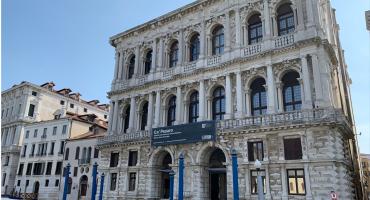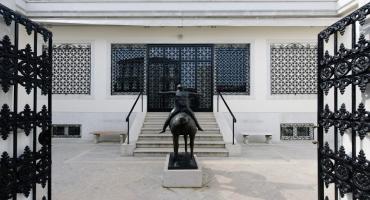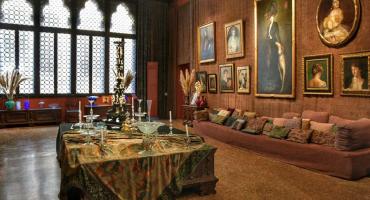The Oriental Art Museum is located in San Stae, in the old Baroque palace of the Pesaro family overlooking the Grand Canal. Inside there is one of the most important European collections of Japanese art of the Edo period (1615-1868) gathered at the end of the nineteen century by Enrico di Borbone during a journey to Asia. The almost 36.000 pieces of oriental art in the museum have been gathered by Prince Henry IV, count of bardi, during his journeys to the Far East between 1887 and 1889. Inaugurated in 1929 and improved over the years, the museum has also sections for China and Indonesia: porcelains, jades, vase lacquers (such as the urushi ones), fabrics and an important collection of weapons of the XII-XIX century.
The Oriental art museum in Venice is one of the most important collection of oriental art in Europe.
Since 1928 it is located at the third floor of Ca’ Pesaro, thanks to an agreement between the Italian State and the municipality of Venice, owner of the palace.
The collection is due to prince Henry of Bourbon, count of Bardi. From 1887 to 1889, during a long journey around the world with his wife Adelgonda of Braganza and a little entourage he visited the South-east Asia, China, Indonesia and Japan, buying nearly 30.000 objects. At his return in Venice, Henry of Bourbon placed his huge collection at Vendramin Calergi palace, where he lived during his stays in Venice. When he died, in 1906, the widow sold the collection to the Viennese antiquarian Trau, that started to sell it. During the First World War the collection, owned by an enemy subject, was seized and passed to the Italian government as compensation for the war damages.
In 1925 the collection was transferred in Pesaro palace. It was Nino Barbantini who organized the exposition in the beautiful baroque palace with frescoes and stuccoes: it was an heterogeneous collection of oriental art, above all Japanese art. For three years he worked hardly and the Museum was opened in 1928: it was a Japanese art exposition with important sections of Chinese and Indonesian art.
Nino Barbantini’s historical set up is still respected even if the exposition has been partly reshaped during some maintenance interventions to gain new spaces of storage for the most delicate artworks.
In the seven rooms dedicate to Japan it is possible to see weapons and amours belonged to the feudal lords of Edo period, lacquer stirrups and saddles, a rare sedan chair for ladies, paintings on silk and paper, precious silk textiles. Two rooms are dedicated to lacquer objects coming from the wedding supplies of the feudal lords’ daughters. The musical instruments are excellent pieces used for the execution of the principal kinds of traditional Japanese and Chinese music. The Japanese artworks belong above all to the Edo period, (from the name of the capital, Edo, nowadays Tokyo) or Tokugawa, from the name of the shōgun family that ruled the country for nearly 250 years assuring the peace to the archipelago and the complete isolation from foreign influences.
The Chinese section includes jade and porcelain of different manufactures, some historical instruments, coins and textiles. In the storage there are also many Quing bronzes, lacquered objects, pieces of furniture and paintings.
In the room dedicated to Indonesia you can find some rare kris, batik textiles and leather figures of wayang, the shadow theatre of Java.
ORIENTAL ART MUSEUM: Total surface sm. 1380; exposition sm 628; storage sm. 380, 10 exhibition areas.
There are information sheets in Italian and English, one video about the history of the collection Bardi collection from private collection to State museum (13’) and about the Japanese urushi Makie. Technique and restoration (9’) in Italian and English; a video about the Japanese Cha no yu and a video about the Indonesian wayang kulit.
Useful Information:
Opening Hours:
Open daily (closed on Mondays)
- Summer (April 1st – October 31st): 10:00 AM – 6:00 PM
- Winter (November 1st – March 31st): 10:00 AM – 5:00 PM
Tickets Price:
First Option:
Valid for both the International Gallery of Modern Art and the Museum of Oriental Art, both located in Ca’ Pesaro.
- Full Price: €14.00
- Reduced Price: €11.50
Available at: https://capesaro.visitmuve.it/en/plan-your-visit/tickets
Second Option: Modern and Contemporary Museums
This ticket includes access to Ca’ Pesaro (International Gallery of Modern Art and Museum of Oriental Art) and the Fortuny Museum.
- Full Price: €15.00
- Reduced Price: €12.00
Available at: https://muve.vivaticket.it/en/tour/ca-pesaro/573
Third Option: Museum Pass
The Museum Pass grants admission to all Civic Museums of Venice, including the Museums of St. Mark’s Square, Ca’ Rezzonico, Ca’ Pesaro, Palazzo Mocenigo, and more.
For more details: https://www.visitmuve.it
- Full Price: €40.00
- Reduced Price: €22.00
Available at: https://muve.vivaticket.it/en/tour/ca-pesaro/573
* Free Admission Days: Every first Sunday of the month, and on April 25th, June 2nd, and November 4th. *
Contacts:
Phone: +39 041 5241173
Email: drm-ven.orientale@cultura.gov.it
For more information, visit: https://orientalevenezia.beniculturali.it
Address: Santa Croce 2076, San Stae, Venice
How to get there: Vaporetto line 1, stop “San Stae”
Copyright Notice: these images have been sourced online. If you are the copyright holder and wish for it to be removed, please contact us.



